Historic Nottingham - Part 1 - Castle Road
w/e 11 March 2007
All this week's pictures were taken
with a Kodak DX6490
This page is the first in an occasional series that
follows another of Malcolm Sales' "100 Walks In Nottinghamshire".
Previous walks from the book have taken us to Wollaton, Wilford
and Thieves Wood near Mansfield but this walk is centred on Nottingham
and starts and ends at the castle gates. A picture of the gates
and a tour of the Nottingham Castle can be seen on a page devoted
to our visit there in September 2004 but we start this walk by
heading off down Castle Road.
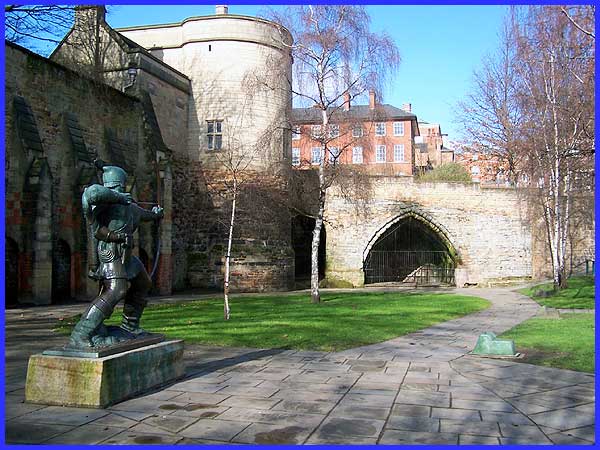
The castle gates also mark the start of the long distance path,
the Robin Hood Way* but our circular route is only one and a
half miles in total through some of the historic city but there
is much of interest to be seen and our first stop is only a few
steps from the start, appropriately at the statue of Robin Hood.
Looking back to the start and following Robin's aim, the outer
bailey bridge built circa 1251-55 that spanned the dry moat is
clearly visible. Not so clear is the round arch to the left that
was inserted later and replaced the original drawbridge.
*If you would like to follow the Robin
Hood Way, Martyn Button completed the route in eight stages during
2004 and 2005 and photos from it are linked from his "Walks"
page at Calverton Cam. Click here to view.
|
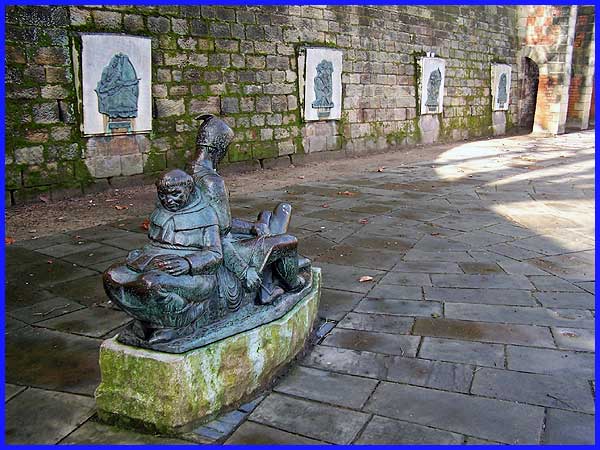
I suppose many would say that the aim of Robin Hood was to relieve
the rich of their wealth and distribute it more equitably. Whether
that meant giving it to the poor or keeping it for himself is
often the subject of debate but legend has it that he was aided
and abetted by a group of merry men. Several plaques built into
the castle walls and some smaller statues around Robin's statue
depict many of his accomplices.
|
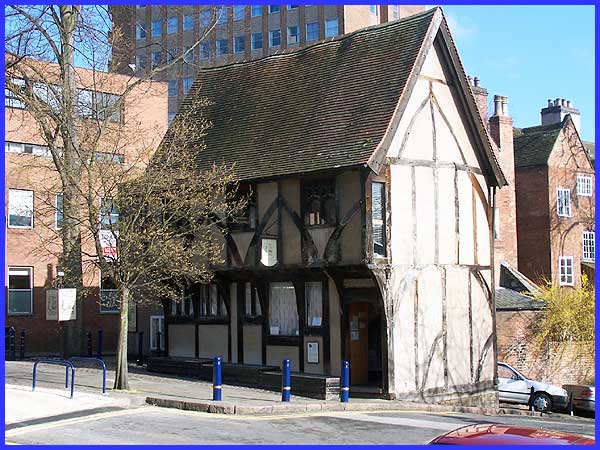
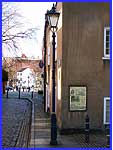 Across Castle Road from the statues
is Severns Building now the home of the Nottingham Lace Centre.
An information board says that the latest evidence suggests it
was built about 1340 and that the window detail was copied from
a fifteenth century building in Exeter. The original windows
were not glazed but had shutters or cloth inside. Severns Building
originally stood a little way from the other end of Castle Gate
in Middle Pavement and was moved to this site in 1969/70. The
name of the building comes from the restaurant and wine merchants
who owned it from 1793 although it was not used for this purpose
until 1939. Prior to that it had been used for many purposes
including accommodation for local workers and merchants. The
lamp post outside on the corner of Castle Gate (left) was one
of the first in Nottingham to be powered by electricity. Across Castle Road from the statues
is Severns Building now the home of the Nottingham Lace Centre.
An information board says that the latest evidence suggests it
was built about 1340 and that the window detail was copied from
a fifteenth century building in Exeter. The original windows
were not glazed but had shutters or cloth inside. Severns Building
originally stood a little way from the other end of Castle Gate
in Middle Pavement and was moved to this site in 1969/70. The
name of the building comes from the restaurant and wine merchants
who owned it from 1793 although it was not used for this purpose
until 1939. Prior to that it had been used for many purposes
including accommodation for local workers and merchants. The
lamp post outside on the corner of Castle Gate (left) was one
of the first in Nottingham to be powered by electricity.
|
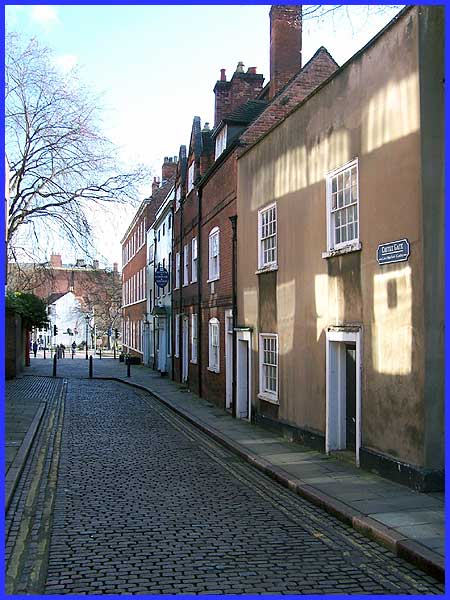
Severns Building stands on the corner of Castle Gate the word
"Gate" coming from the Danish "gata" meaning
"street". In the nineteenth century the street along
with the Pavements, High, Middle and Low, housed many of the
wealthiest citizens. Even in the eighteenth century, the properties
(especially those on the right hand side) were much sought after
as they afforded excellent views over long gardens and meadowland
to the River Trent. Probably the most famous occupant of Castle
Gate was the commander of the French Army at the Battle of Blenheim
in 1704, Marshall Tallard. He was captured by the Duke of Marlborough
and lived on parole in Newdigate House from 1705 until 1711.
|
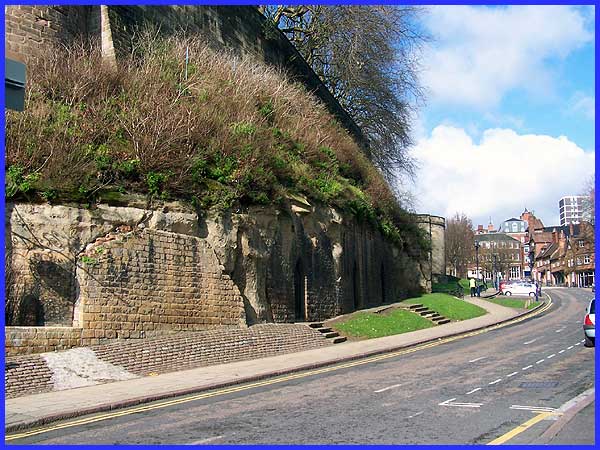
Our route is not along Castle Gate however, but to continue down
Castle Road at the foot of the castle walls. Another information
board near the traffic warden in the yellow fluorescent jacket
in this image, gives a potted history of the landscape from pre-historic
times and tells how the River Trent had its course diverted by
a persistent patch of ice in the Vale of Belvoir at the end of
the Ice Age. The river cut a valley through the sandstone leaving
steep cliffs on either side. It was on one of these that Stone
Age people existed and later a settlement that eventually grew
up to be Nottingham was established. The sandstone of course
owes its origin to a much earlier time - some 240 million years
ago when sand and pebbles were deposited by a great river before
the Atlantic Ocean was formed but that's another story not for
the telling here.
|
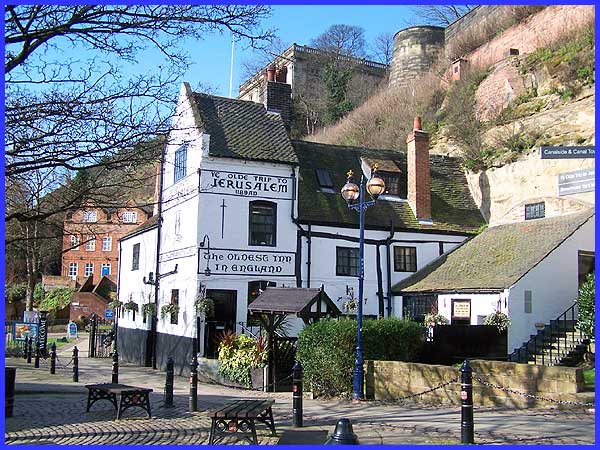
Not quite so far back in time but reputed to be the oldest inn
in England is "Ye Olde Trip To Jerusalem". In his book
Malcolm Sales writes that it is "one of the oldest inns
in Nottingham" but doesn't cite anything as being older.
Whichever you believe, it has certainly been there a long time
and the date painted on the wall below the name reads 1189AD.
With cellars and a chimney built into the sandstone, the inn
is said to be haunted and has a fascinating history. The name
owes its origin to the fact that Crusaders often called in on
their way to the Holy Land but if you would like to know more
about the inn, there is a dedicated website here. Also to be seen in
this image is the present castle building high above and on the
left are the entrance gates to the Brewhouse Yard Museum which
we will take a closer look at in the next part of this occasional
series.
|

